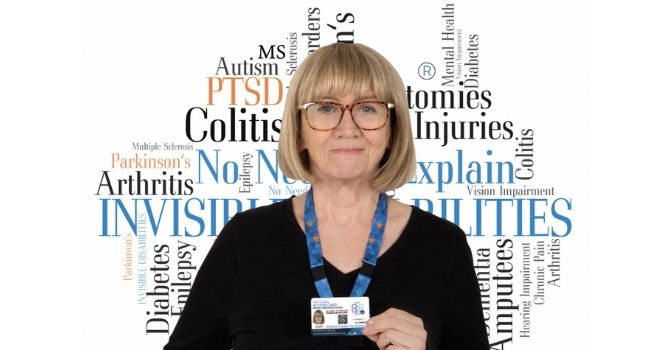An estimated five million Australians live with an invisible disability, which is a disability that cannot be seen.
There’s a saying, “out of sight, out of mind”. Unfortunately, this describes the experience of many people who have invisible disabilities. A recent study found that 92% of people with invisible disabilities feel there is a lack of understanding in the community about what invisible disabilities are and their prevalence.[1]
Invisible Disabilities Australia (IDA) is trying to change that. Leap in! caught up with founder Lynn Russell to talk about the impact of disabilities you can’t see and the work of IDA to support practical change.
Lack of understanding and facilities.
Invisible disabilities can significantly impact a person’s life and their ability to complete day-to-day tasks. There are hundreds of invisible disabilities including multiple sclerosis, autism, brain injuries, Parkinson’s disease, chronic pain and more.
Because their impact differs greatly from person to person, only some people with invisible disabilities are eligible for the NDIS.
Studies show that many people often feel scared and uneasy in public places, making access more difficult. Lynn Russell has experienced this first hand.
Five years ago, a life-saving surgery associated with a cancer diagnosis resulted in Lynn acquiring an invisible disability.
Lynn went from being highly active and involved in her community to being scared of airports, galleries, queues and just about any public place. She was shocked at the lack of suitable toilets for people with medically diagnosed medical conditions and general awareness of the needs of people with invisible disabilities.
“The lack of understanding and facilities adds immense anxiety to an already challenging situation,” says Lynn. “Often there is no suitable bathroom for people with ostomies to use, toilets are locked or unavailable and I’m regularly abused for using disabled toilets because I don’t look disabled.”
A survey of more than 800 people with invisible disabilities found:
- 85% said more accessible car parking is needed
- 74% had been verbally harassed or insulted when using a disabled parking bay or toilet
- 57% self isolate due to a lack of accessible facilities and lack of understanding.
Shining a light on invisible disabilities.
Lynn is a long-time equity and human rights advocate who has been working to make a difference in the lives of others for 36 years. She has been involved in disability advocacy, elder abuse awareness, foreign policy and housing equity, among other things.
After speaking with a wide range of people with invisible disabilities, including many with visible disabilities who also have invisible disabilities, Lynn found her experiences were common.
She launched Invisible Disabilities Australia to shine a light on the needs of people with invisible disabilities and help organisations fulfil their legal obligations to comply with anti-discrimination laws.
“Everyone has a right to be able to actively and equally participate in public life. It’s not ok for places like galleries, supermarkets, airports and shopping centres to have nowhere to sit down if needed or not to have toilets that everyone can access. We can’t just cater for most and not all of us,” Lynn said.
“There are many people who cannot stand in a queue, who may struggle with overwhelming environments or who may need urgent bathroom access. Others may be nonverbal and not able to ask for the assistance they need.”
No need to explain – the National Access Card.
IDA has launched a National Access Card and lanyard combined with a business ambassador program to help people with invisible disabilities get discreet assistance when it’s needed. The personalised photo ID card has the words “Special Assistance” along with the person’s name on the front and the help required on the back.
“We now have a national system so people can instantly recognise when someone needs support,” Lynn said. “IDA cards provide evidence of your need for support and/or access to a disabled or non-public toilet. People can choose to wear the card and lanyard out of sight and simply show it as required. There should be no need to explain the condition to get the support needed.”
The cards include a QR code that connects to a page on the IDA website that explains that the person displaying the card may need support.
Thousands of Australians are already using the cards. Businesses are invited to join the world-first initiative as ambassadors and be added to the map of safe locations. Individuals can show their support by becoming a Badge Ambassador and wearing an ambassador badge.
IDA has also developed an ostomy-friendly public toilet design that has already been installed in several locations in the ACT and will continue to advocate for more accessible public places.
“We want recognition and support for people with disabilities and a society that is inclusive of the needs of everyone,” Lynn said. “Often, people are unkind to people with invisible disabilities due to lack of awareness. IDA’s Communication Cards and Lanyard are the starting point for a national conversation.”
Access cards and lanyards are available for sale on the Invisible Disabilities Australia website. NDIS participants who are plan managed or self manage may be able to use their NDIS funds to purchase the cards and IDA car magnets
[1] Blue Badge Insurance, Invisible Disabilities Week 2021, accessed 15 November 2021.
How Leap in! can help you make the most of your NDIS Plan.
Our experienced plan managers are here to answer your questions and provide support. Our award-winning plan management app makes it easy to manage your NDIS funding in real time, keep your spending on track and get alerts when you are underspending or overspending in any budget.
Call us on 1300 05 78 78 or sign up to Leap in! plan management today.
Further reading
NDIS Consumables budget guide 2021

